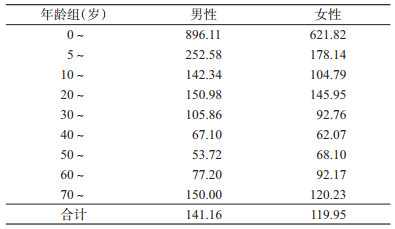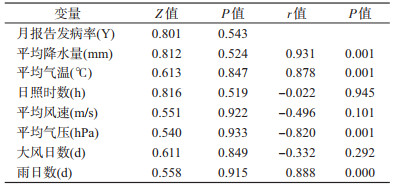文章信息
- 杜真, 张婧, 卢金星, 卢亮平.
- Du Zhen, Zhang Jing, Lu Jinxing, Lu Liangping.
- 北京市2004-2015年细菌性痢疾分布特征及气象影响因素分析
- Association between distribution of bacillary dysentery and meteorological factors in Beijing, 2004-2015
- 中华流行病学杂志, 2018, 39(5): 656-660
- Chinese Journal of Epidemiology, 2018, 39(5): 656-660
- http://dx.doi.org/10.3760/cma.j.issn.0254-6450.2018.05.022
-
文章历史
收稿日期: 2017-11-10
细菌性痢疾是由志贺菌属引起的常见肠道传染病,人群普遍易感,具有全年散发和季节性流行的特点,属于我国法定报告的乙类传染病。气象因素是影响疾病发病率与季节分布的重要因素,在全球气候变暖的整体趋势下,气象因素与疾病的关系日益受到关注[1-5]。本文对2004-2015年北京市细菌性痢疾分布特征进行时空描述分析,并探讨气象因素与其发病率的相关关系,为预防和控制细菌性痢疾提供科学依据。
资料与方法1.疫情资料:2004-2015年北京市细菌性痢疾的发病资料通过中国CDC传染病报告信息管理系统获得。气象资料由历年北京市统计年鉴获取,气象因素主要包括降水量、平均气温、最低气温、最高气温、日照时数、平均风速、平均气压等。
2.方法:2004-2015年北京市细菌性痢疾的发病资料做描述性流行病学分析,并计算各月的平均发病率,进行月平均发病率与各气象因素的相关性分析。采用Excel 2013软件计算率和构成比,SPSS 20.0软件进行相关和回归分析。
结果1.疫情概况:2004-2015年北京市共报告细菌性痢疾患者280 704例,死亡36例,年平均报告发病率为130.15/10万,以散发为主,无暴发疫情发生。报告发病率最高的是2005年,报告病例数37 531例,报告发病率为244.29/10万;报告发病率最低的是2015年,报告病例数9 724例,报告发病率为45.18/10万。2004年以来北京市细菌性痢疾报告发病率呈逐年下降趋势,但仍高于全国水平(图 1)。

|
| 图 1 2004-2015年全国及北京市细菌性痢疾报告发病率 |
2.地区分布:2004-2015年全市区(县)均有病例发生,年平均报告发病率为129.78/10万。2012年东城区和崇文区、西城区和宣武区合并前以丰台区、朝阳区和东城区的年均报告发病率最高,分别为226.05/10万、203.60/10万和203.16/10万,合并后以丰台区、东城区和朝阳区的年均报告发病率最高,分别为182.19/10万、158.94/10万和151.60/10万。东城区和崇文区、西城区和宣武区合并前后怀柔区的年均报告发病率均最低,分别为77.56/10万和71.61/10万(表 1)。
3.时间分布:2004-2015年间全年均有病例报告,发病集中在5-10月,历年7-8月报告病例数均在1 000例以上,2004-2007年7-8月报告病例数高达6 000例以上。5-10月为发病高峰期,报告病例数226 229例,占总报告病例数的80.75%,其中8月报告发病数最高,有明显的季节性发病规律(表 2)。
4.人群分布:报告病例中男性153 735例,女性126 409例,男女性别比例为1.22 : 1。细菌性痢疾在各年龄组均有发病,报告发病率最高的为0~组,其中男性报告发病率为896.11/10万,女性报告发病率为621.82/10万。50~岁年龄组的男性报告发病率最低,为53.72/10万;40~岁年龄组的女性报告发病率最低,为62.07/10万(表 3)。
5.职业分布:各职业人群均有病例报告,报告发病数最多的是散居儿童60 316人,占21.53%,其次是学生46 681人,占16.66%,渔(船)民仅报告5例(表 4)。
6.气象因素分析:
(1)单因素相关分析:北京市2004-2015年的平均降水量、平均气温、日照时数、平均风速、平均气压、大风日数和雨日数与细菌性痢疾报告发病率进行单因素相关分析,月报告发病率与平均降水量、平均气温和雨日数呈正相关,r值分别为0.931、0.878和0.888,与平均气压呈负相关,r值为-0.820,与日照时数、平均风速和大风日数无直线相关关系,月报告发病率和气象因素情况见表 5,数据的正态性检验及相关分析见表 6。
(2)多元线性回归分析:月报告发病率与平均降水量(X1)、平均气温(X2)、日照时数(X3)、平均风速(X4)、平均气压(X5)、大风日数(X6)和雨日数(X7)多元逐步回归分析显示,仅平均降水量进入方程,回归方程为Y=3.792+0.162X1(表 7)。对拟合回归方程的方差分析结果显示,F=65.150,P=0.001,认为方程有统计学意义(表 8)。
细菌性痢疾是夏秋季常见的肠道传染病之一,在法定细菌性传染病中的报告发病率位居首位。北京市的细菌性痢疾报告发病率明显高于我国同期其他地区[6-7],本研究对2004-2015年北京市细菌性痢疾的流行特征进行分析并探讨气象因素对该病的影响作用。结果显示,除2007年报告发病率略有回升外,总体呈下降趋势,提示随着居民生活水平提高和卫生条件的改善,细菌性痢疾的发病情况已经得到有效控制。
人群对痢疾杆菌普遍易感,发病多与不良卫生习惯和人群抵抗力下降相关,从该病的发病规律来看,农村地区高于城市,儿童高于成年人,且存在明显季节性。分析显示,2004-2015年北京市细菌性痢疾的报告发病率仍以散居儿童和学生为主,0~岁年龄组报告发病率最高,且集中在5-10月,除去地理位置等因素外,与国内其他研究基本一致[8-10]。北京市作为首都城市,其经济和卫生水平总体较好,但细菌性痢疾的发病远高于全国水平,与该病的发病规律不符,这可能与北京地区传染病报告质量总体质量良好,漏报率较低,而部分农村或者经济相对落后地区患者自购药物治疗以及该地区传染病漏报率较高有关[11-13]。
研究表明,北京市2004-2015年细菌性痢疾的报告发病率与平均降水量、平均气温和雨日数呈正相关,与平均气压呈负相关,这与贾蕾等[14]和陈伟等[7]的研究基本一致,该两项研究平均气温和平均降水量均纳入回归方程,但本研究仅平均降水量进入方程,提示平均降水量是影响细菌性痢疾报告发病率的重要影响因素。许新等[15]的研究表明,洪涝灾害可使灾后人群的细菌性痢疾发病风险明显升高,其影响因素可能包括病原体快速增长、管道交叉污染、基础卫生设施缺乏等。结合本研究结果,提示当降水量明显增加时,应及时做好细菌性痢疾的预防控制措施。
随着中国疾病预防控制信息系统建设的日臻完善和疫情报告人员意识的增强,传染病漏报率逐渐降低,各地的报告发病率日趋准确,在综合考虑各地社会经济条件和医疗卫生水平的前提下,对影响细菌性痢疾发病影响因素的分析将更加有利于该病的预防控制工作。
利益冲突: 无
| [1] |
马盼, 李若麟, 乐满, 等. 气象环境要素对北京市消化系统疾病的影响[J]. 中国环境科学, 2016, 36(5): 1589–1600.
Ma P, Li RL, Yue M, et al. Impacts of meteorological factors and environmental pollutants on digestive diseases in Beijing[J]. China Environ Sci, 2016, 36(5): 1589–1600. DOI:10.3969/j.issn.1000-6923.2016.05.046 |
| [2] |
李娟, 张志薇, 于庚康, 等. 气象要素对南京市呼吸系统疾病的影响研究[J]. 气象科学, 2017, 6(3): 409–415.
Li J, Zhang ZW, Yu GK, et al. Impact of meteorological factors on respiratory diseases in Nanjing[J]. J Meteor Sci, 2017, 6(3): 409–415. DOI:10.3969/2016jms.0050 |
| [3] |
彭朝琼, 蔡军芳, 余淑苑, 等. 深圳市空气中PM2.5与医院呼吸系统疾病门诊日就诊人次的关系研究[J]. 中华预防医学杂志, 2016, 50(10): 874–879.
Peng CQ, Cai JF, Yu SY, et al. Impact of PM2.5 on daily outpatient numbers for respiratory diseases in Shenzhen, China[J]. Chin J Prev Med, 2016, 50(10): 874–879. DOI:10.3760/cma.j.issn.0253-9624.2016.10.008 |
| [4] |
王鲁茜, 闫梅英, 方立群, 等. 云南省伤寒副伤寒空间分布特征及其气候影响因素研究[J]. 中华流行病学杂志, 2011, 32(5): 485–489.
Wang LX, Yan MY, Fang LQ, et al. Typhoid and paratyphoid fever in Yunnan province:distributional patterns and the related meteorological factors[J]. Chin J Epidemiol, 2011, 32(5): 485–489. DOI:10.3760/cma.j.issn.0254-6450.2011.05.015 |
| [5] |
许磊, 李贵昌, 司晓艳, 等. 长爪沙鼠鼠疫自然疫源地气候对鼠疫流行影响的非线性效应[J]. 中国媒介生物学及控制杂志, 2016, 27(4): 321–325.
Xu L, Li GC, Si XY, et al. Nonlinear effects of climate driven plague in Meriones unguiculatus natural foci in Inner Mongolia[J]. Chin J Vector Biol Control, 2016, 27(4): 321–325. DOI:10.11853/j.issn.1003.8280.2016.04.002 |
| [6] |
隋吉林, 张静, 孙军玲, 等. 2009年中国细菌性痢疾监测分析[J]. 疾病监测, 2010, 25(12): 947–950.
Sui JL, Zhang J, Sun JL, et al. Surveillance of bacillary dysentery in China, 2009[J]. Dis Surveill, 2010, 25(12): 947–950. DOI:10.3784/j.issn.1003-9961.2010.12.006 |
| [7] |
陈伟, 刘颖, 陈正利, 等. 河南省2010年细菌性痢疾流行特征及其与气象因素相关性分析[J]. 现代预防医学, 2012, 39(22): 5818–5820.
Chen W, Liu Y, Chen ZL, et al. Analysis on relativity between epidemic characteristics of bacillary dysentery and meteorological factors in Henan Province in 2010[J]. Mod Prev Med, 2012, 39(22): 5818–5820. |
| [8] |
黄艳萍, 唐光鹏, 蔡星和, 等. 2005-2011年贵州省细菌性痢疾监测分析[J]. 现代预防医学, 2014, 41(11): 2092–2094.
Huang YP, Tang GP, Cai XH, et al. Analysis and surveillance on bacillary dysentery data of Guizhou province from 2005-2011[J]. Mod Prev Med, 2014, 41(11): 2092–2094. |
| [9] |
刘海霞, 刘新凤, 于德山, 等. 甘肃省2010-2014年细菌性痢疾流行病学及病原学临床特征分析[J]. 中国卫生统计, 2016, 33(6): 969–971, 975.
Liu HX, Liu XF, Yu DS, et al. Epidemiological and etiological characteristics of bacillary dysentery in Gansu province, 2010-2014[J]. Chin Health Stat, 2016, 33(6): 969–971, 975. |
| [10] |
谢冰艳, 孙传武. 江苏省徐州市2006-2015年细菌性痢疾流行病学特征分析[J]. 实用预防医学, 2017, 24(4): 482–485.
Xie BY, Sun CW. Epidemiological characteristics of bacillary dysentery in Xuzhou city, Jiangsu province, 2006-2015[J]. Pract Prev Med, 2017, 24(4): 482–485. DOI:10.3969/j.issn.1006-3110.2017.04.029 |
| [11] |
蒋仁保, 高慎男. 菌痢报告发病率农村低于城市问题分析[J]. 现代预防医学, 2007, 34(24): 4733–4734.
Jiang RB, Gao SN. Analysis of the reported incidence of bacillary dysentery in rural areas below in the cities[J]. Mod Prev Med, 2007, 34(24): 4733–4734. DOI:10.3969/j.issn.1003-8507.2007.24.061 |
| [12] |
霍飞, 许婕, 夏卫东, 等. 2004-2012年天津市医疗机构法定传染病漏报情况分析[J]. 疾病监测, 2013, 28(11): 943–946.
Huo F, Xu J, Xia WD, et al. Underreporting of notifiable communicable diseases in medical institutions in Tianjin, 2004-2012[J]. Dis Surveill, 2013, 28(11): 943–946. DOI:10.3784/j.issn.1003-9961.2013.11.021 |
| [13] |
谢学勤, 陈晨, 杨晓英, 等. 北京市医疗机构传染病报告质量的现况分析[J]. 中华预防医学杂志, 2008, 42(5): 335–338.
Xie XQ, Chen C, Yang XY, et al. Analysis of the quality of notifiable infectious disease report in Beijing medical treatment organizations[J]. Chin J Prev Med, 2008, 42(5): 335–338. DOI:10.3321/j.issn:0253-9624.2008.05.011 |
| [14] |
贾蕾, 黎新宇, 刘桂荣, 等. 北京气象因素与细菌性痢疾发病关系的研究[J]. 现代预防医学, 2007, 34(13): 2470–2471, 2480.
Jia L, Li XY, Liu GR, et al. Analysis of the association between meteorological factors and incidence of dysentery in Beijing[J]. Mod Prev Med, 2007, 34(13): 2470–2471, 2480. DOI:10.3969/j.issn.1003-8507.2007.13.029 |
| [15] |
许新, 刘志东, 韩德彪, 等. 辽宁省2004-2010年洪涝灾害对细菌性痢疾发病影响的分析[J]. 中华流行病学杂志, 2016, 37(5): 686–688.
Xu X, Liu ZD, Han DB, et al. Study on influence of floods on bacillary dysentery incidence in Liaoning province, 2004-2010[J]. Chin J Epidemiol, 2016, 37(5): 686–688. DOI:10.3760/cma.j.issn.0254-6450.2016.05.020 |
 2018, Vol. 39
2018, Vol. 39










